LP12MF Listening Test: Tiger Paw Khan Top Plate
A few weeks ago, I swapped out the stock stainless steel top plate from my Linn LP12 and installed an aluminum Tiger Paw Khan in its place. You can read about the installation process for the Khan, and check out my listening methodology. Full listening impressions on the Khan-modified LP12 are below; digestible, numerical summaries of all my listening tests are here.
tl;dr
I was genuinely not expecting this to make much of a difference in terms of sound quality — I’m still not sure how it can, really. I mostly wanted the Khan to have Perfectly Perpendicular spring bolts, to make setup easier; I would have been Perfectly Pleased with my investment (about $600 USD used, the same price I paid for the Mober subchassis, my previous upgrade) if that’s all it did.
But, lo’ and behold, it made a difference. Not as much of a difference as the Mober subchassis — the average improvement was 5% per track with the Khan, versus 8.75% for the Mober — but nonetheless a fairly obvious one. If you dare delve into the dreadfully detailed notes below, you’ll see a theme: most test tracks had a more natural, easy, lifelike presentation, and a wider soundstage, with each instrument located more clearly in space, with room to do its thing. (And this is with headphones on, mind you; this would be even clearer in a good loudspeaker setup, I’m sure.)
I realize that these are all hi-fi reviewing clichés. But they are also just the most accurate way of describing the difference — which, I now see, must be how these clichés became clichés. Starting this LP12MF of mine, I was skeptical that any upgrades would actually make a positive difference. I was fully ready to conclude that hi-fi reviewers are all just full of it, spewing nonsense from their golden ears (sorry for the mixed-orifice metaphor there, also rife with clichés). It has been a surprise to me to see how much better music can sound — I’ve never had a setup nearly this expensive or fancy in my life, and it sounds really nice. It’s also restored some of my faith in humanity. Apparently hi-fi reviewers aren’t all full of shit. Good equipment sounds better. And it sounds better by making music sound more lifelike and more natural, including by situating instruments and musicians more clearly in space. Go figure.
Anyway, one interesting wrinkle this round is that not all tracks sounded better. Indeed, two sounded worse. As you’ll see, these were two of the first three I tested, so that I was fully prepared to scream “KHAAAAAAAN!!!!!!!” But then everything after those two sounded better, often much better. I have a theory as to why these two sounded worse — not a terribly complicated theory. They’re both pretty old pressings, and they both have noticeable surface noise. It’s possible that these pressings have groove wear, and that the Khan, by making my system more revealing generally, has more clearly revealed groove wear. (My hope is that these pressings are in fact just dirty; see “next steps” below.) If this is the case, then the fact that these discs now sound worse would actually show that the system is performing better, extracting more information (or, in this case, damage) from the groove. So the 5% improvement might not reflect the full difference that Khan has made.
Notes on casual listening
Before getting to the formal testing of tracks, some impressions gathered during two weeks of obsessive vinyl-listening with the Khan installed.
The first thing that I noticed on plugging the Khan-ed LP12 back into my system was that the music seemed… louder? I’m not sure this is true, or possible, but that’s what it seemed like. Discs where I normally had the volume at 12 o’clock were now sitting at 11. It also seemed like I didn’t need to turn the volume dial up as high for the music to sound good — that quality was achieved at lower loudness. Again, weird, but that’s what I felt.
The major thing that happened — and there’s no denying this; indeed, it really started to bug me — was that I began noticing “pre-echo” in ways I never have before. I had definitely noticed it on a few records before; now I was hearing it on pretty much every record, and very loudly on some. (For more on this irritating phenomenon, see this post on the Steve Hoffman forum.) I suppose this was, again, because the turntable was extracting more “information” from the groove than before. Although this was annoying, it seemed like solid evidence that the Khan was making a positive difference in the crucial business of information retrieval.
In general, I had the distinct sense that records were sounding better. I felt like I was getting more detail, especially on the high end (more “splash” on the cymbals, especially) and more percussive hit on piano notes. The bad side was that records that previously sounded really beautiful (Clifford Jordan in the World, most notably) were left in the dust by others (especially Prince Lasha’s The Cry! and Anthony Williams’s Life Time) that had more information to reveal in this more revealing setup. In other words, I had the sense that nicely produced and pressed records were showing their talents more clearly.
Discs that sounded particularly good this round were the following.
From my list of test albums:
- Go-Betweens, 16 Lovers Lane
- Music from Twin Peaks
- New Order, Low-Life (I had no idea this was so well produced: smooth, expansive analogue synths, very deep bass)
Off-list:
- Oliver Nelson, Blues and the Abstract Truth (early 70s Japanese pressing — WOW!!!!!)
- Eric Dolphy, Iron Man and Far Cry (also both 70s Japanese pressings)
- Clifford Jordan, Glass Bead Games (2019 Pure Pleasure reissue)
Test tracks
Okay, onto the track-by-track tests — in which two important breakthroughs are made in the vocabulary of hi-fi reviewing, both related to the act of vomiting.
- The “gross test” is established. Henceforth, if switching from one format to another makes you say “gross” and make an actual barfing motion, the difference between them is 20% or greater.
- The term “pixel-barf” is coined. It’s one of the clearest ways I’ve come up with to explain the difference between a nice-sounding and a bad-sounding recording, especially if the bad one is digital. (“Pixel-barf” is the fuzzy gunk around the edges of a sound, where there should be fine, gentle, filigreed detail.)
1. The Beach Boys, “I Know There’s an Answer,” Pet Sounds (1966)
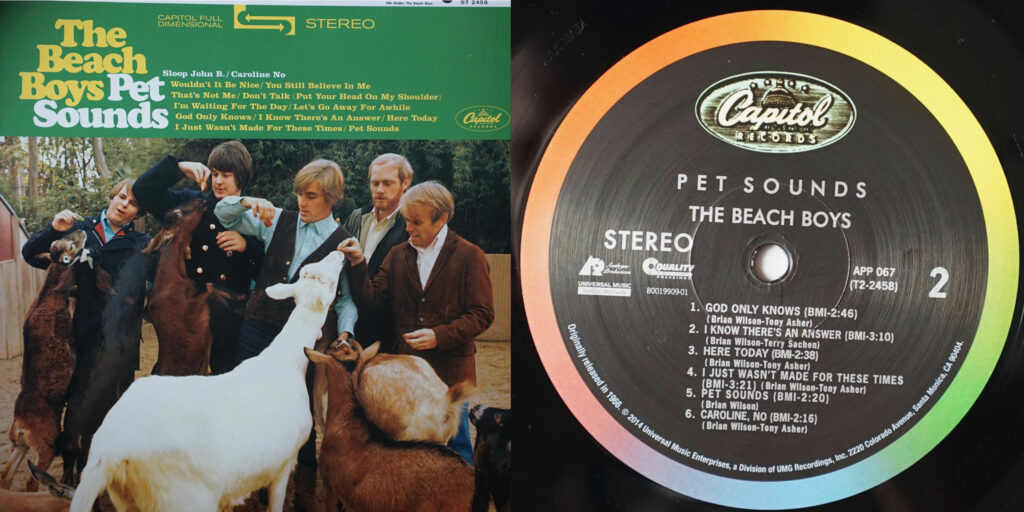
Full digital. After weeks of listening to almost only vinyl, I’ve developed a sort of disdain for the digital, and wasn’t expecting much. But I know this one was tied with vinyl last time… It sounds fine, especially the bass, which is nice and deep. But I’m definitely not blown away by any aspect of this, perhaps because I’ve been spoiled by all that vinyl in the last few weeks.
Vinyl full. This sounds better to me. More life in the cymbals, wider soundstage, more thump in the tympani. Definitely not ming-blowing like many of the listening experiences I’ve had lately (Oliver Nelson, Iron Man… Prince Lasha again!), so perhaps this just isn’t a very thrilling pressing/recording — it does sound a little soft in the middle, around Brian’s voice when he’s singing, a little hazy and cloudy. But my hunch is that this has gotten a little better. We’ll see in the direct comparisons.
Slight delay. Still hard to compare due to level differences… and it does seem that the LP12 has gotten a little louder since adding the Khan (how is that possible?). So I don’t fully trust these delayed impressions, since getting the level right is tricky with a 10-second delay. But it does seem that the vinyl sounds a bit better: the digital duller, lacking punch and texture, lacking the full width and depth I’m hearing from vinyl.
Second-to-second. Some minimal evidence of the vinyl sounding a little bit better: tympanis are rounder, cymbals a little sharper. But the differences are small. Very very very slight edge to vinyl.
Verdict: vinyl 5% better (5% improvement)
2. Charles Mingus, “Track B — Duet Solo Dancers,” The Black Saint and the Sinner Lady (1963)
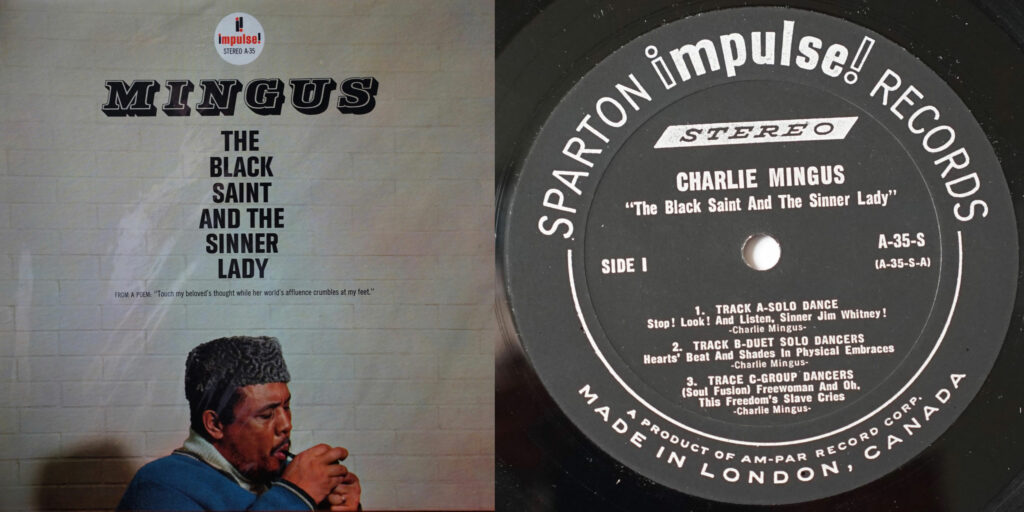
Full vinyl. Surface noise is annoying, giving everything a grainy quality. Listening past it, nice helicopter rumble, nice ambient instrument noises (someone hitting their horn against a music stand?). Plenty of heft in the descending buh-buh-buh-buh-buh section. And a nice kind of “cordy” quality to the… is that a tenor sax in the left channel? — like a knotty texture, very palpable, that strikes me as the kind of thing digital will struggle to match. The drums in the muted trumpet section near the end sound particularly lifelike — something to note on comparisons. The downside is the graininess, which is I think mostly imparted by the slightly worn pressing.
Full digital. Things definitely sound cleaner, neater, more polite. I notice duller-seeming cymbals, more plodding bass. More screamy brass. Constantly wanting to turn the volume up for better quality and then being forced to turn it down by screamy sounds. The “cordy” part around 2:20 feels less cordy here. Drums do sound very nice and lifelike in the muted trumpet part around 4:40.
Slight delay. I guess I can see how I got messed up on this one last time. At times, it seemed like the vinyl sounded way worse (grainy, imprecise), at others there seemed to be more texture. All in all, I left this one with the impression that digital was a little better: although it’s hard to listen past surface noise, even then it seemed like the digital was a little finer with the details, especially cymbals. More splash and extension.
S-2-s. Very, very close. As always, volume is a problem: am I just turning it up until it sounds equally good when I switch from digital to vinyl? And how does one really listen past surface noise? On balance, digital has a slight edge on texture, digital a slight edge on detail. But I’m not terribly happy with my choice of this record any longer: the surface noise makes it tricky to compare, adding a bit of graininess to the whole track. Of course, if vinyl ever does sound convincingly better than digital, that’ll be something…
Verdict: digital 5% better (5% deterioration)
I also own a copy of Black Saint in the 2019 “Vital Vinyl” European reissue, which I believe was cut from a hi-res digital source. I thought I’d try comparing it, too, since the 1963 first pressing above is grainy and has some surface wear. I only did the Second-to-second comparison.
S-2-s with Vital Vinyl edition. Much better detail on vinyl in “cordy” part. Cymbals less grating, less “tizzy” on vinyl. Authoritative bass on vinyl. Drums more lifelike on vinyl in the muted trumpet section. Richer, smoother on vinyl but still with tons of detail. Now it’s digital that sounds grainy.
Vital Vinyl verdict: +10% vinyl (no comparison to last round; I didn’t listen to this pressing)
Interesting in lots of ways, especially since the source file for the vinyl pressing is probably the same file I’m pulling from Tidal. It suggests: (a) contemporary pressings from digital sources can sound very good on vinyl, probably because the DAC conversion at the studio is much better than my own DAC; (b) a cheap repressing can sound much better than an original disc in reasonable condition (this one is about VG+). I’ll keep listening to this pressing (as well as the original) in future listening tests. I’m especially interested to see how the 1963 original responds to an ultrasonic cleaning…
3. The Pentangle, “Let No Man Steal Your Thyme,” The Pentangle (1968)
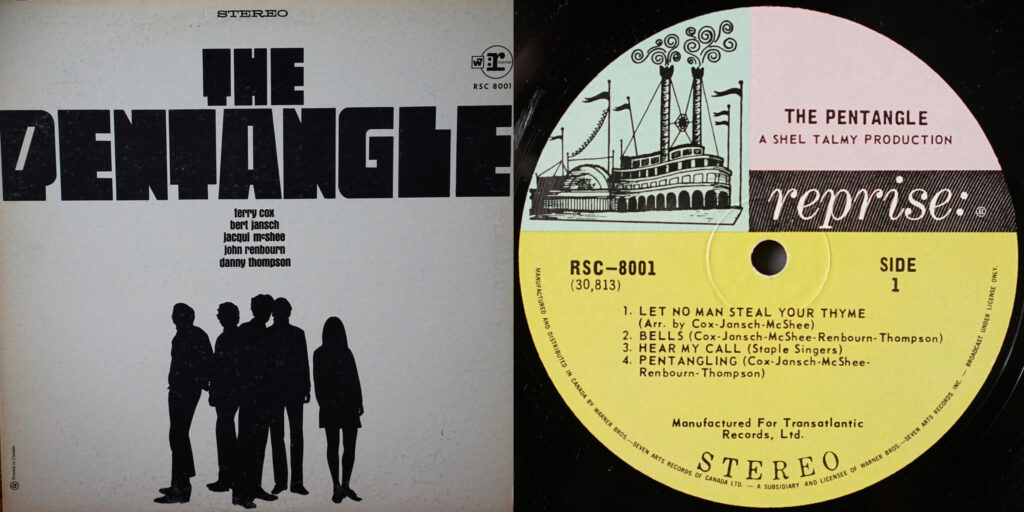
Digital full. Sounds impressive — the bowed bass is huge, the acoustic guitar piercingly bright, the rim hits and tinkles really clear and present. Digital is having a good night!
Vinyl full. Oh, great — another disc with surface noise. Sounds duller, less focused than digital.
Slight delay. Very little to separate them once the levels are really sorted. A little bit more “ting” on the triangle and cymbals on digital, perhaps? The surface noise is annoying and definitely adds a bit of filter to the music.
S-2-s. As above, slight edge to digital — nicer “ting,” bowed bass hits just a bit harder, has more impact on digital.
Verdict: digital 5% better (5% deterioration)
[While typing up these notes, I’ve been listening to a vinyl copy of Bert Jansch’s and John Renbourn’s unadventurously-titled-but-brilliant album Bert and John, of which I picked up a recent reissue at this year’s Boxing Day sale at Rotate This for $12. I needed some virgin vinyl to ease my mind after the surface noise trauma induced by these two discs (“KHAAAAAAAAN!!!”), which are making me rethink my whole transition to vinyl (I BOUGHT AN ULTRASONIC CLEANER YESTERDAY FOR GOD’S SAKE!!!). Anyway, while listening to “Goodbye Pork Pie Hat” (Mingus cover!), I heard a dog barking, and took off my headphones, thinking it was coming from outside my door. But I don’t have a dog! I put the headphones back on. Yep, there it was in the background, the totally lifelike, totally convincing sound of a little hound barking about 15 feet to my left. I’ve listened to this album many times — always on Tidal — and never noticed this before. It seems I’m not alone in hearing the dog barking, either — and so not just going nuts. Something to make me feel a little better about the resolving capacity of my system, anyway — and about both Bert and John too, for not being so fussy while recording as to banish their dog from the studio.]
4. Mariah, “Shinzo No Tobira,” Utakata No Hibi (1983)
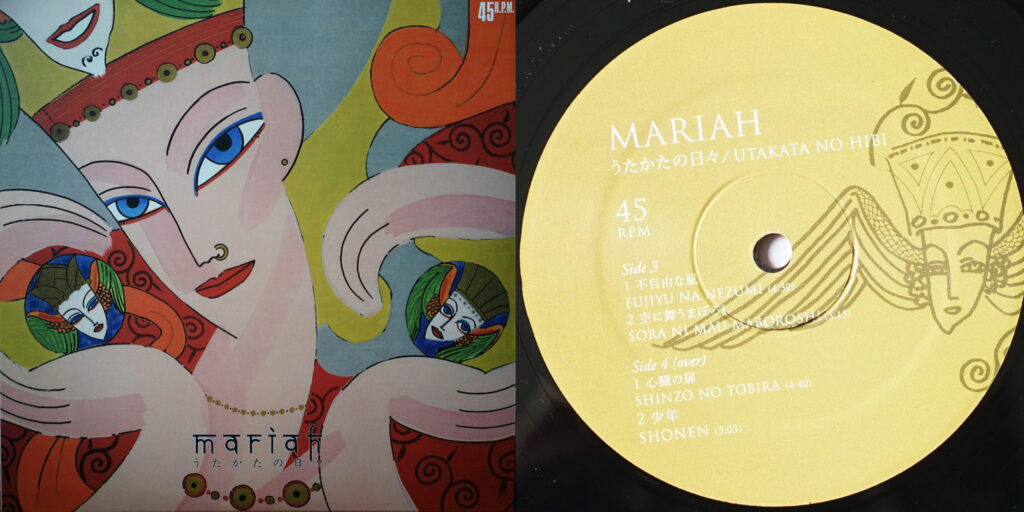
Full vinyl. Sounds distinctly excellent, light and detailed and crisp. When the bass-y part kicks in, it occupies a nice, big, fat round part of the soundstage while the little rattles do their thing softly and distinctly at the outer extremities. Real sense here of separation between instruments / voices / sounds in the soundstage. Breakdown sounds nice but isn’t slamming especially hard.
Full digital. Maybe a little less delicacy, less fliligree to the rattles? Bass sounds more muted, dull, less “round” and graspable. I’ve learned that my impressions on full listens, even back to back ones like this, are often shown to be way off when I do a direct A-B. But this definitely strikes me as sounding quite a lot worse than the vinyl. Just veiled, dull, hazy compared with vinyl.
Slight delay. Yeah, it’s still there on the delay. Much more impact, slam, real-ness on vinyl. Nicer detail on the rattles, fuller tone on the bass. There’s a hollow, distant tone to the vocals on digital. Very perceptible difference. There is more of everything in the vinyl: more slam, more high end, more focus, more detail.
S-2-s. As above. More of everything on vinyl. Much more refined, defined, pleasant sound. Switching back and forth is like draping and undraping a (thin) veil.
Verdict: vinyl 10% better (5% improvement)
5. Joy Division, “Atmosphere,” 12″ single (1980)
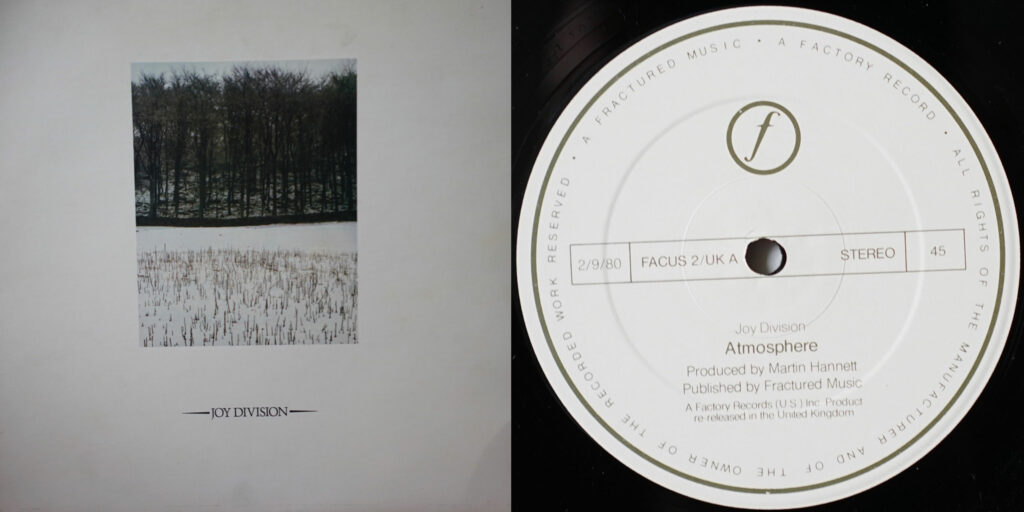
Full digital. Definitely sounds “digital” to my increasingly spoiled ears. I hear the veil, despite it obviously still sounding nice and being well-produced. I can imagine exactly how the drums, in particular, could/will sound better on vinyl.
Full vinyl. From previous tests, I’ve gotten to know how good this disc sounds, and how exciting those first tom hits can be. Actually, I was a little nervous they wouldn’t sound as good as I remembered. But they do, producing a full-body “OMG” sensation. This song is just magnificently alive in its vinyl version. We’ll see in the direct comparisons whether it’s gotten any better relative to digital, but it still definitely sounds amazing. I feel like I’m hearing the tuning of the drums in ways I never have before…
Slight delay. The quick drum playing in the right channel is beautifully distinct on vinyl, barely even audible on digital. No impact to the drums on digital; tons on vinyl. Everything is squeezed into a muddy little snowball in the digital; it’s like looking into a whole galaxy on vinyl. Seriously. Massive difference.
S-2-s. Exactly as above. (Fellow audiophiles, consider listening to this incredible pressing of this incredible track. Insane drum sound.)
Verdict: vinyl is 25% better (10% improvement)
6. Low, “Just Make It Stop,” The Invisible Way (2013)
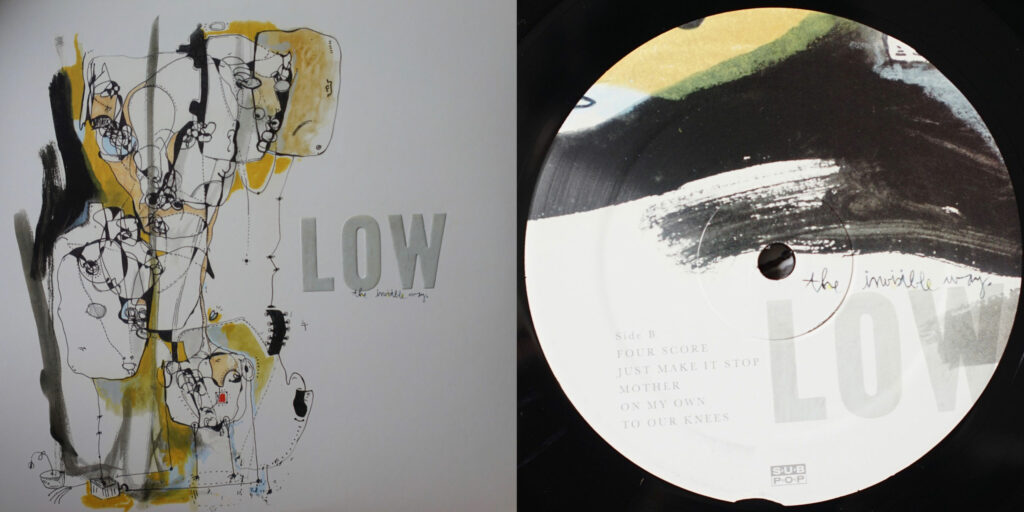
Full digital. Low sounds way better than Joy Division in digital. Full, rich sound, maybe a little constrained on Mimi’s vocal, maybe a little fuzzy when the soundstage gets busy with lots of instruments and loud playing. But, anyway, not an unpleasant sound — probably the kind of sound I was excited about when I first got this setup and these headphones!
Full vinyl. Sounds terrific, and seemingly better. No sense of constraint on Mimi’s vocals. Same width and depth, but more detail in the brushes and the piano way out on the left. Both ears sort of “popping” along with the beat — a real percussive feel from the piano on the left and whatever that is on the left (another piano?).
Slight delay. Wow. Massively more detail in brush, piano, and bass on vinyl. More definition, detail, decay on vinyl. Muffled, flat, narrow on digital. Lively, dynamic, alive on vinyl. Big difference!
S-2-s. As above. (Eek, the source selector switch on my Mjolnir headphone amp is starting to make a scratchy noise. I’m definitely using it more than the average person. I hope it doesn’t crap out on me; it’s sort of important.)
Verdict: vinyl is 15% better (10% improvement)
7. Yo La Tengo, “Stockholm Syndrome,” I Can Feel the Heart Beating as One (1997)
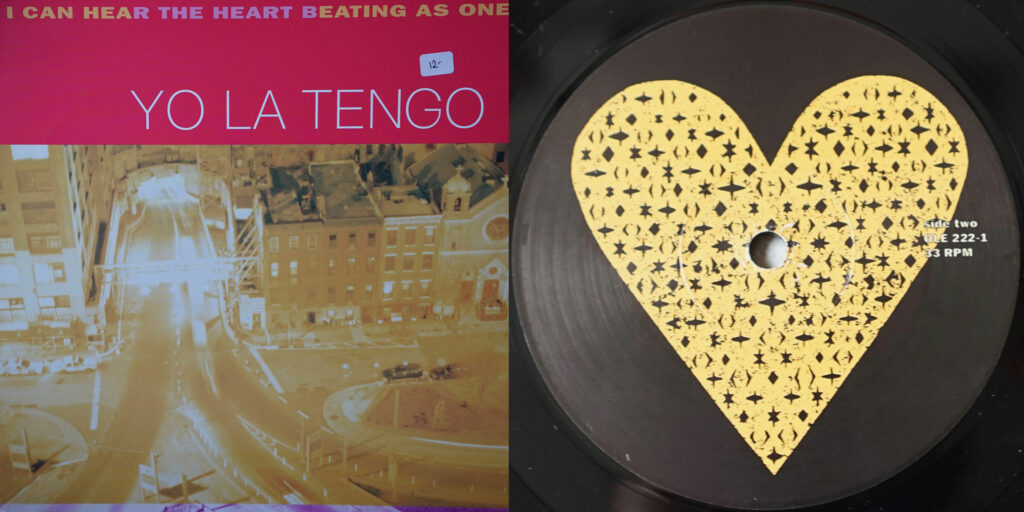
Full digital. Sounds really nice — I don’t think I’d have any complaints outside of direct A-B testing. Rereading my last listening report, it’s sort of hard to believe that vinyl sounded 15% better than this.
Full vinyl. Okay, yeah, the guitar really sparkles, the soundstage seems wider, James’s voice is very “near” and in focus. Soundstage widens really nicely in the chorus. (There is some noticeable surface noise, but it’s not annoying — no evidence of actual groove wear.) It’s definitely the strummed texture of the acoustic guitars that stands out.
Slight delay. The digital is boxy, muddy, crowded, dull. Just so much more texture and detail and tactile punch during the solo, especially the acoustic guitars.
S-2-s. Total fog-lifting situation. Vinyl miles ahead. It’s nuts when comparing individual instruments: the bass is flabby on digital, tight and focused on vinyl; the drums are indistinct and flat on digital, tight and sharp on vinyl. Of course I’ve already gone on sufficiently about the acoustic guitars. As with Bill Callahan last time, the digital feels gross after the vinyl.
Verdict: vinyl is 20% better (5% improvement)
8. The Beatles, “While My Guitar Gently Weeps,” The White Album (1968)
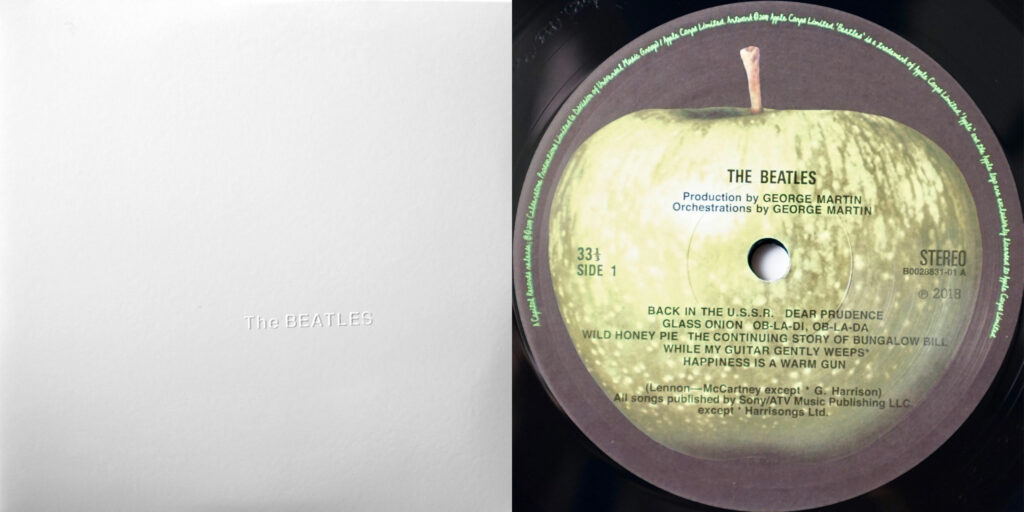
Full digital. This is a much nicer sounding file [remember, this is the fancy Giles Martin remix — both the hi-res digital file and the vinyl pressing, which was obviously made from a hi-res digital file]. There is a kind of stridency and hollowness to the left-channel guitar that I can imagining sounding better on vinyl. The bass drum and bass guitar do sound really great. The sound in general is a little sharp, strident, tiring. Are the shakers a little grainy around 3:30? I keep wanting to turn the volume down a little more, and a little more…
Full vinyl. Really nice decay on the right-channel cymbals in the opening. Not getting that “strident” feeling — well, maybe a bit with the guitar in the left channel. Plenty of heft on the bass drum and bass — the bass drum, especially, is nice and round. I feel like I’m hearing a new instrument, dead-centre, right behind George’s voice — like an autoharp or something? Anyway, definitely not harsh-sounding, definitely not feeling that need to turn down the volume.
Slight delay. Digital does sound a little plinky, sharp, attacky. Vinyl sounds more assured, more natural, fuller. Digital soundstage is constrained, mushy. Instruments are less distinct. Haziness. Low end is flabby. Really big difference. So weird how the Khan has massively improved the performance on some tracks, made it worse on others…! Digital isn’t quite “gross” in comparison, but not far off. (Let’s call “gross” the 20% threshold.)
S-2-s. Yep. Flipping to digital, the soundstage shrinks, the instruments retreat into a fog, the tones seem off, the impact is lessened. It’s actually really close to “gross”… but let’s say…
Verdict: vinyl is 15% better (10% improvement)
9. Dungen, “Panda,” Ta Det Lugnt (2004)

Vinyl full. Wowweee, yes, that opening drum part is pretty amazing. The guitars are just totally savage. The drum kit incredibly alive. The vocals are in their own little teleporter-beam cylinder dead-centre in soundstage, surrounded by those massive drums on the edges. Now the temptation is to turn way UP and just rock the f^%k out. Anyway, yep, sounds about as good as I can imagine rock n’ roll sounding. This is a brilliantly-chosen test track — slightly ahead of Joy Division, Can, and Julee Cruise as the one I enjoy listening to the most.
Digital full. Yeah, sure, pretty good, but clearly not anywhere near the vinyl. On to the direct comparisons…
Slight delay. Hmm, not quite past “gross” I don’t think, but the digital is hazy, unfocused, lacking in detail, full of sound and fury but signifying nothing. (That’s actually a pretty good description of what digital sounds like tonight; thanks, Bill.) Vinyl just sounds relaxed, open, effortless, natural.
S-2-s. Okay, no, it is “gross.” Hollow, distant, almost echoey on digital. Soundstage is insanely wider on vinyl. Drums are the main thing (I guess as the only unprocessed acoustic instrument on the track). Cymbals in particular just sound just disgusting on the digital version. So, like I said, gross. (I actually just made an involuntary barfing motion when switching.)
Verdict: vinyl is 20% better (5% improvement)
10. Julee Cruise, “Rocking Back Inside My Heart,” Floating Into the Night (1989)
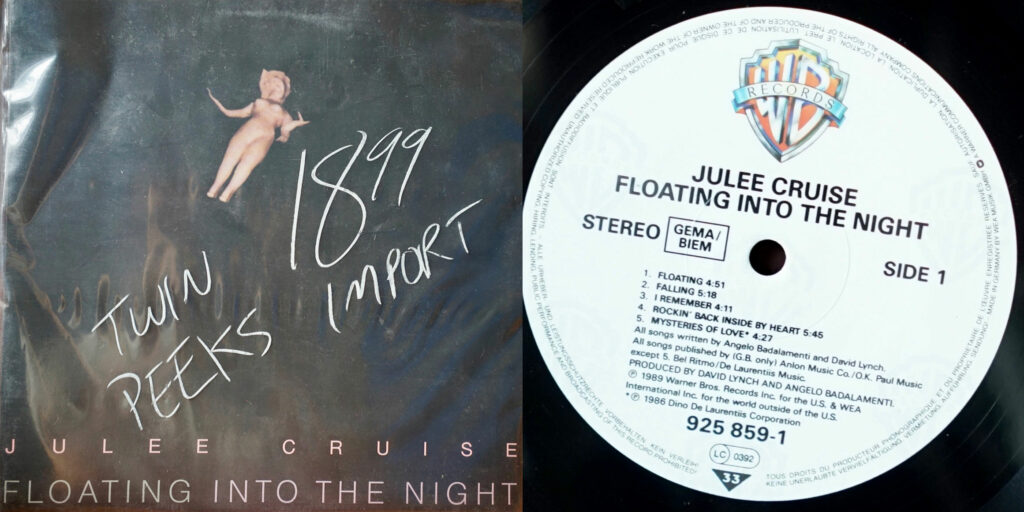
Full vinyl. A deeply satisfying aural experience, from the very first seconds. Crisp piano, dreamy vocals, those fuzzy palm mutes, super wide soundstage. Sax freakout is huge, rich, varied, wide, lovely. This was such a good choice of a test track. Nice sub-bass right before the first “Do you remember…” What a strange and beautiful song, always teetering right on the balance point between innocence and terror.
Full digital. It definitely doesn’t sound terrible. The bass is nice and full, if maybe a little out of focus. I’d say what it’s lacking is just that, focus, combined with some delicacy. Piano definitely seems less present. The synths seem more present, though?
Slight delay. Those palm mutes are very revealing: on digital, one big deep-fried-together thunk; on vinyl, a whole bunch of thin, long, separable little strands working together. The piano on the left channel is also a real distinguisher: much crisper, more discernible on vinyl. This is a super-literal and obvious example, but imagine a digital photograph of a face, where, zoomed in, the tiny strands of hair that border the head will either be lost or expressed through some weird little pixel-barf that doesn’t look anything like hair, just some little brown squares hanging in space. The digital has that kind of pixel-barf around the edges of all the instruments here, and the vinyl just doesn’t. You see the hair, just like you would with your actual eye. The question now: is digital “gross” in comparison?
S-2-s. Thick veil on digital. The sax breakdown settles it: yes, digital is “gross” in comparison. Not as obviously anywhere else, but very obviously in that part. Pixel-barf everywhere. I near a raincoat to do these tests.
Verdict: vinyl is 20% better (5% improvement)
11. Can, “Halleluwah,” Tago Mago (1971)
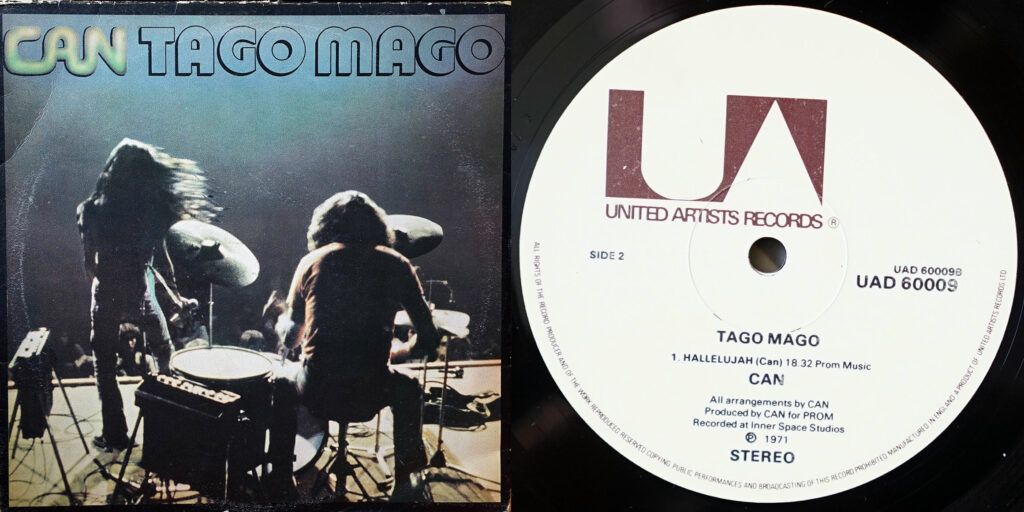
Full vinyl (listening up to the quiet part and just a bit beyond). First impression, after the gorgeous sounds coming out of the Julee Cruise record, is that this record does not sound as good. Things are a little flat at the beginning. There is a slight hollowness or hardness throughout. The drums do sound huge when they start getting a little angry. Anyway, I’m going to hypothesize that this one won’t utterly destroy digital as the above discs have been doing, either because the original recording isn’t spectacular or this particular pressing is a little worn.
Just for fun here, I’m going to pull out my 1981 Celluloid repress of this album and see how it compares to this first UK pressing. The Celluloid sounds quite a bit different — way more bass, a little less of that hardness, but maybe a little less resolution and detail. Maybe a wee bit less slam in the drums. Definitely sounds great — different (softer, bassier) rather than better/worse, I’d say… Incredible presence on the hi hat on the left channel in the section immediately before the quiet part
Full digital. Sounds big and meaty like the Celluloid, but noticeably with a little less detail and finesse. Of course my audio memory now doesn’t extend to the UK first press. This does sound good, though. Definitely one of the better-sounding digital audio files I’ve got in this batch. I do still think I hear the deficiencies, though: the lack of extension and splash… the pixel-barf, as it were (wow, my reviewing vocabulary is getting pretty advanced, huh?).
Slight delay (with UK first press). More detail in vinyl, if a little less fullness than digital. Hmm, no, that seems to go away after the first minute or so — the UA vinyl is plenty full. Then it’s a clear win for vinyl: more detail, more slam. Not “gross,” I don’t think, but more than 5% better. More life, less glaze. More bite, more penetrating highs. The rattles just before the soft part are much more convincing on vinyl. The tickle sounds (like ropes tightening on a wooden knob) after the soft part are much more lifelike on vinyl. Digital just has that glaze.
S-2-s. Teetering on the verge of grossness. Soundstage is confused, compressed, muddied on digital. Hi hat is tizzy on digital, much more natural on vinyl. Drums just sound totally fake on digital, no roundness, no life. When I start writing notes and forget which source I’m on, the splashy pixel-barf is immediately apparently on digital — there’s no mistaking it. Very close to gross, but I think just inside it. Tons of pixel-barf on the quiet brushy sound in the quiet part. Tickle sounds not too close.
Verdict: vinyl is 15% better (10% improvement)
For fun, a quick S-2-s with the Celluloid pressing. Celluloid is also clearly better than digital, more detail, more natural drums and hi hats especially. It’s definitely fuller and bassier than the UK first press. But it’s generally not as good as the UA, not as detailed perhaps. 10% advantage here at most. Some details, like the left-channel hi hat, disappear at times. The chuckle-rattle before the soft part is only marginally nicer on the Celluloid. So yes, here’s a case where the first pressing really does sound better.
Verdict: Celluloid vinyl is 5% better
12. Bill Callahan, “Javelin Unlanding,” Dream River (2013)
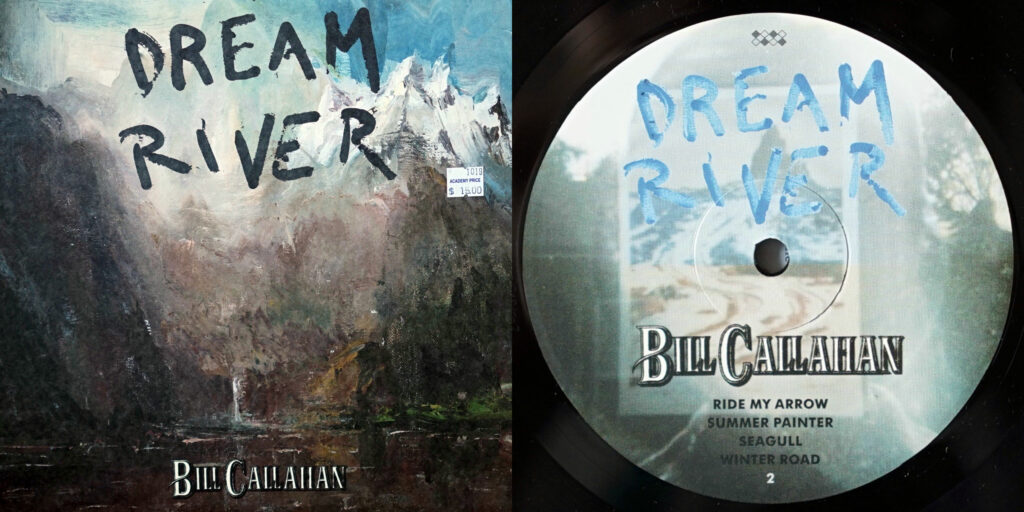
Digital full. I know from my notes that this was one that sounded way better on vinyl last time. Interesting, because it really doesn’t sound so bad here on first listen. Maybe the cymbals are a little tinny and the flute a little flat. But I definitely would have gotten excited about a recording like this pre-LP12MF. Excited to hear how much better the vinyl is…
Vinyl full. I can see it. Instruments seem set much further apart, each playing in their own space and at their own volume, not all kind of mushed together. Compared to some of the other incredible records I’ve been listening to, I don’t think this one is particularly outstanding in terms of production or pressing quality. But it sounds nice, and nicer than the digital version, for sure. (One thing on this track that is incredibly well-recorded: Bill Callahan’s voice. Like Leonard Cohen’s voice on those two last records, it just jumps out of space — or falls out of it like a massive boulder.) (Bit of surface noise here, but not enough to detract from the experience.)
Slight delay. Digital is flat, pixel-barfy, lacking in detail around the edges. Vinyl is natural, controlled, easy. Really big difference here. Definitely beyond “gross.” Digital is just so hazy, foggy. I don’t want to listen to it.
S-2-s. Digital is boomy, unfocused. The main thing about vinyl is how clean, open it is, with clarity on every instrument and loads of space between them. Callahan sounds like he has a cold in the digital version. Definitely “gross,” but not “beyond gross,” I don’t think, in head-to-head comparison.
Verdict: vinyl is 20% better (5% improvement)
Next steps
Once again, I am delighted and surprised to see that installing something relatively expensive into my turntable makes it sound better. (But why does that surprise me, again?) The next upgrade was going to be the Linn Lingo 4 motor and power supply that has been sitting in my basement for the past several months. But last week I had the misfortune of stumbling upon London Jazz Collector’s review of the Audio Desk Vinyl Cleaner Pro ultrasonic cleaner. Then I went on Canuck Audio Mart and saw that a local dealer was selling an ex-demo unit with a full warranty at less than half the new cost. I couldn’t resist. LJC suggests thinking of the Audio Desk as a component, so I’m going to treat it as such, giving it its own round of the LP12MF.
The Linn theory is to start from the outside and work your way in toward the groove. Following that theory, I will proceed as follows:
- The disc itself (Audio Desk Vinyl Cleaner Pro. Wait, is this skipping ahead to the last step? Oh, who knows. Anyway, I’m doing it next.)
- The motor that turns the platter (Linn Lingo 4)
- The platter itself (Mober SSP12)
- The bearing that the platter sits on (Mober bearing)
- The tonearm and the subchassis that holds the bearing (I’ll do the Kore + Ekos 2, then the Greenstreet + Aro)
- The cartridge that sits in the tonearm (I’ve got a Linn Troika and a Dynavector XX2. I might try these out on my Roksan Nima arm before swapping tonearms.)

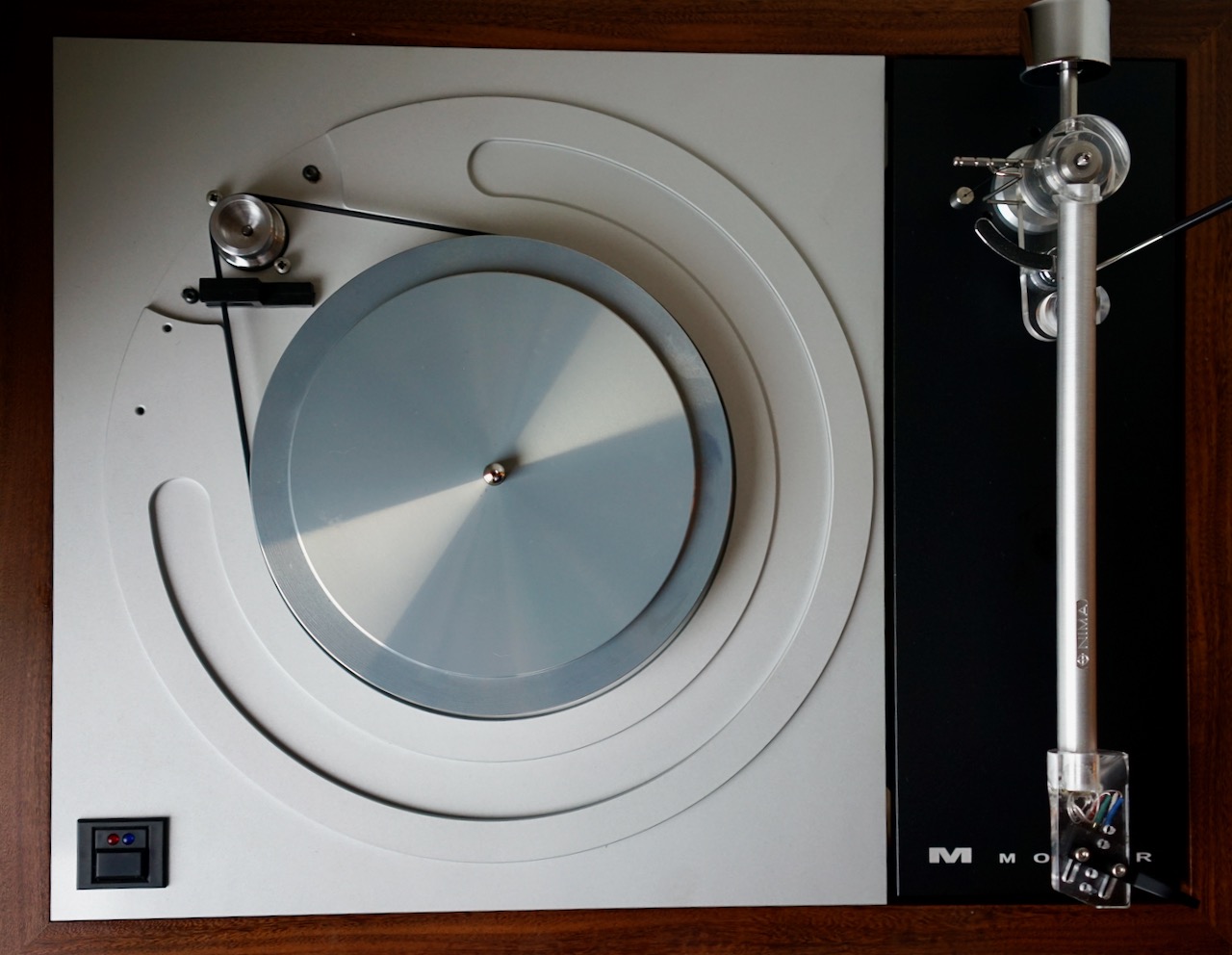
1 Comment
Join the discussion and tell us your opinion.
Pre-echo can either be an artefact of the analogue master tape recording process and what happens during long term storage or is an artefact of the vinyl mastering process. The phenomenon for pre-echo on tapes is called ‘print through’ and is a consequence of how magnetic tape is spooled on a reel and how the magnetic fields ‘imprint’ on the tape either above or below. Print through starts immediately after a recording is completed and increases with time, for as long as the tape is stored.
A different kind of pre-echo results directly from the LP cutting process. Basically, as the cutter cuts the lacquer with a signal it displaces the lacquer, pushing the lacquer out on other side of the groove wall – it is this echo that is replayed and heard. The louder the signal, the more displacement of the lacquer occurs and the more you hear.
Insofar as hearing more of either phenomenon with your upgrades, this is a product of how much better your turntable, arm and cartridge is at not only more accurately tracing the groove, but the turntable systems ability to extract and replay low level signal detail. In short, such improvements are exactly what you’d expect to be revealed by improving the mechanical integrity of your LP replay system!
Finally, it takes little imagination or effort to deduce why print through can sometimes be heard on digital recordings, as it comes from either master tape print through or because some recordings are recorded from turntables, where both effects may be (almost) faithfully captured and reproduced!
On a more generally note, I have greatly enjoyed reading your posts, although I have noticed some typos!
Have fun!